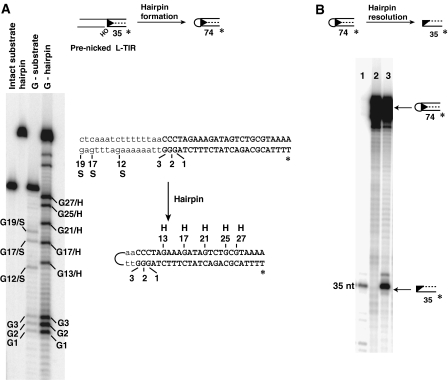Figure 4.
Sequence of the transposon end hairpin and resolution by the transposase. (A) Sequence of the transposon end hairpin. Maxim–Gilbert G-reaction of the hairpin intermediate formed from a pre-nicked piggyBac L-TIR substrate displayed on a denaturing acrylamide gel. G-substrate: G-reaction of the intact piggyBac L-TIR fragment with flanking DNA; G-hairpin: G-reaction of the piggyBac L-TIR hairpin; G/S: G-reaction of substrate; G/H: G-reaction of hairpin. The L-TIR is shown in uppercase and the flanking donor DNA in lowercase; the top and bottom strands of piggyBac L-TIR are joined by means of a 4 nt hairpin derived from the donor strand flanking the 5′ end of the transposon. Only part of L-TIR substrate and corresponding hairpin are shown. (B) piggyBac transposase can resolve a pre-formed transposon end hairpin. Transposase was incubated with L-TIR13-3-19 oligonucleotide containing a TTAA hairpin for 20 min. Lane 1, the 3′ strand of L-TIR13-3-19 as a marker; lane 2, hairpin DNA without piggyBac transposase incubation; lane 3, hairpin DNA with piggyBac transposase incubation.

